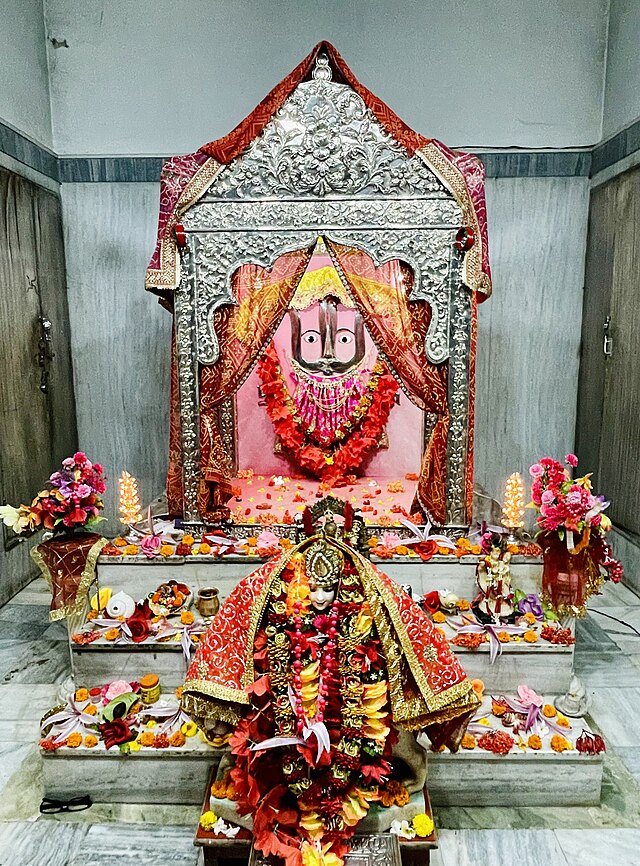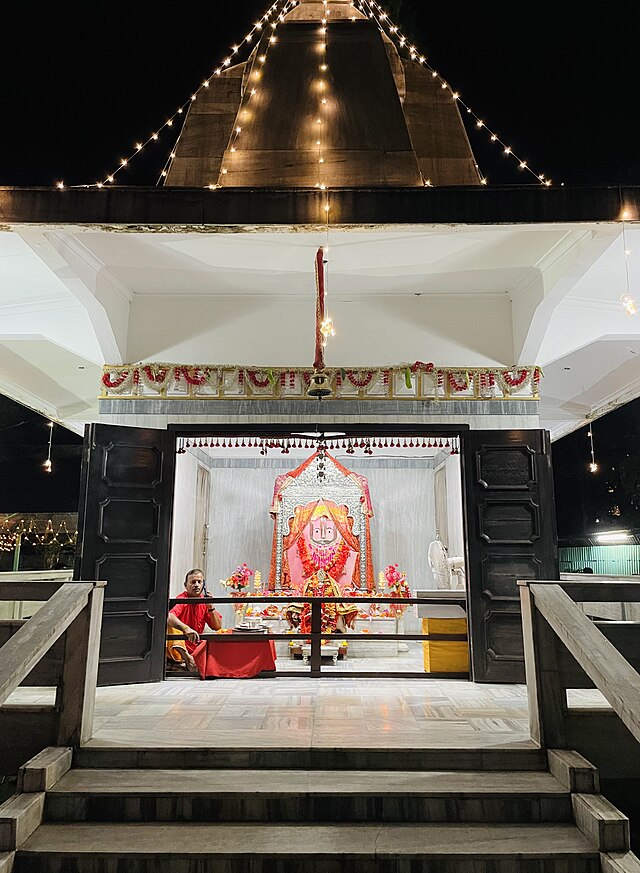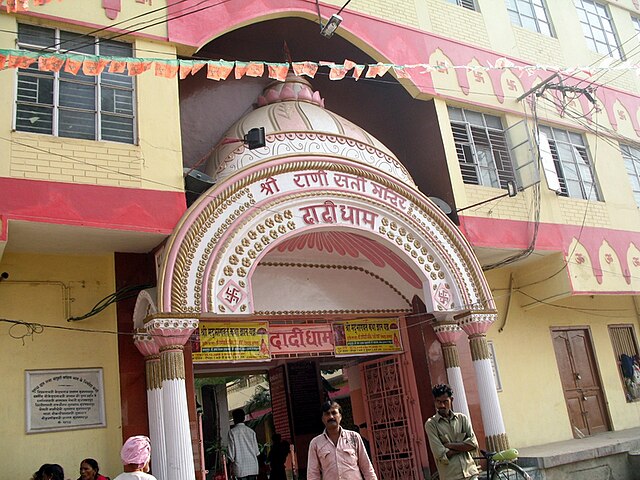Have you ever heard of a temple that’s not just a place of worship but a vibrant symbol of courage, devotion, and architectural grandeur? Nestled in the heart of Jhunjhunu, Rajasthan, the Rani Sati Mandir stands tall as one of India’s most revered pilgrimage sites. Dedicated to Rani Sati, also known as Narayani Devi or Dadiji, this 400-year-old temple is a testament to feminine strength and spiritual legacy. Whether you’re a devotee seeking blessings or a traveler chasing cultural treasures, this temple has something for everyone. Let’s dive into the story, significance, and splendor of this iconic landmark!
The Legend of Rani Sati: A Tale of Bravery and Sacrifice
Every great temple has a story, and the Rani Sati Mandir’s tale is one that tugs at the heartstrings. The legend revolves around Narayani Devi, a young Rajasthani woman whose life is said to be intertwined with the epic Mahabharata. Picture this: a young bride, deeply in love, facing unimaginable loss. According to folklore, Narayani was the reincarnation of Uttara, the wife of Abhimanyu, the valiant warrior from the Mahabharata. When Abhimanyu was killed in battle, Uttara wished to perform sati (self-immolation) but was stopped by Lord Krishna because she was pregnant. Krishna granted her wish to fulfill her devotion in her next life.
Fast forward to her next birth, Narayani was born in Dokwa village to Gursamal Birmewal. She married Tandan Jalan, a merchant from Hisar who owned a magnificent horse coveted by the local king’s son. When Tandan refused to part with his prized possession, a deadly duel ensued. Tandan defeated the prince but was later killed by the enraged king. In a display of unparalleled courage, Narayani fought and defeated the king, avenging her husband. True to her vow, she then performed sati, commanding her loyal servant Ranaji to arrange her cremation alongside her husband. She blessed Ranaji, declaring that her name would forever be linked with his as Rani Sati. Isn’t it incredible how a single act of devotion has inspired millions for centuries?
A Connection to the Mahabharata
The temple’s mythology doesn’t just stop at Narayani’s life. Its roots dig deep into the Mahabharata, connecting devotees to a timeless epic. The story of Uttara and Abhimanyu adds a layer of spiritual depth, making the temple a bridge between ancient history and modern faith. For many, visiting Rani Sati Mandir feels like stepping into a living chapter of India’s mythological past. Can you imagine the weight of such a legacy?
Architectural Marvel of Rani Sati Mandir
Walking into the Rani Sati Mandir is like stepping into a Rajasthani palace. The entire structure is crafted from gleaming white marble, giving it a regal aura that’s hard to miss. The exterior walls are adorned with vibrant, colorful frescoes that narrate the temple’s history and the life of Rani Sati. These intricate paintings aren’t just decorative—they’re storytelling masterpieces that draw you into the temple’s sacred narrative.
Inside, the temple complex is a sprawling seven-acre wonderland. Unlike many traditional temples, there’s no idol of a deity here. Instead, a trishul (trident), symbolizing power and divine energy, takes center stage. This unique feature sets the Rani Sati Mandir apart, emphasizing its focus on spiritual strength over conventional iconography. The complex also houses smaller shrines dedicated to Lord Shiva, Hanuman, Ganesha, and the Sodash Matrika (16 mother goddesses), each adding to the temple’s divine ambiance.
Notable Features of the Temple Complex
The temple isn’t just about worship—it’s a full-fledged spiritual and cultural hub. A massive Lord Shiva statue stands proudly in the center, surrounded by lush gardens that offer a serene escape from the bustling city. The interiors are a feast for the eyes, with exquisite murals and glass mosaics that depict the legend of Rani Sati in vivid detail. There’s also a dharamshala (guest house) for pilgrims, a canteen serving delicious vegetarian meals, and even a girls’ school and marriage hall for the underprivileged. It’s like a small, self-sustaining village dedicated to devotion and community service!
The Twelve Sati Shrines
Within the main temple, you’ll find twelve smaller shrines dedicated to other satis, each with its own story of sacrifice and devotion. These shrines add a layer of reverence, reminding visitors of the countless women who embodied courage and loyalty. It’s a humbling experience to walk through these sacred spaces, isn’t it?
Spiritual Significance of Rani Sati Mandir

For the Marwari community and devotees across India, Rani Sati is more than a historical figure—she’s an embodiment of Maa Durga, the goddess of strength. Her story resonates as a symbol of feminine power, loyalty, and unwavering faith. Devotees flock to the temple to seek blessings for courage, family well-being, and prosperity. The temple’s secular ethos is remarkable—people from Hindu, Muslim, Sikh, Jain, and Christian backgrounds visit with equal devotion, making it a shining example of India’s pluralistic spirit.
The absence of a traditional idol and the worship of a trishul emphasize the temple’s focus on inner strength and divine energy. For many, this makes the spiritual experience more personal and profound. Have you ever visited a place that felt like it spoke directly to your soul? That’s the magic of Rani Sati Mandir.
The Controversy Around Sati Pratha
Let’s address the elephant in the room: the temple’s association with sati, a practice banned in India. The temple management is clear—they oppose the glorification of sati pratha. A prominent sign outside the sanctum declares, “We oppose the practice of sati.” This stance reflects the temple’s commitment to honoring Rani Sati’s courage and devotion without endorsing outdated customs. It’s a delicate balance, but one that ensures the temple remains a place of spiritual reflection rather than controversy.
Festivals and Celebrations at Rani Sati Mandir
The Rani Sati Mandir comes alive during festivals, transforming into a vibrant hub of devotion and celebration. The most significant event is the Bhado Amavasya festival, held on the no-moon day in the month of Bhadrapad. Imagine thousands of devotees, colorful processions, and the air filled with chants and prayers—it’s a spectacle that’s both humbling and exhilarating. During this time, the temple hosts a grand pujanotsav (worship ceremony), drawing pilgrims from across India and abroad.
Other festivals like Navratri, Diwali, and Holi are celebrated with equal fervor. The temple’s Navratri celebrations, in particular, are a sight to behold, with devotees offering special prayers and participating in traditional Rajasthani folk performances. It’s like a spiritual carnival that blends faith with festivity!
The Annual Mela: A Cultural Extravaganza
Though the official mela (fair) associated with the temple is banned due to concerns over sati glorification, the atmosphere during Bhado Amavasya feels like a fair in spirit. Stalls selling prasad, flowers, and religious items line the streets, and the temple complex buzzes with energy. It’s a time when Jhunjhunu transforms into a melting pot of faith and culture, drawing everyone from local families to international tourists.
How to Reach Rani Sati Mandir
Planning a visit? Getting to Rani Sati Mandir is easier than you might think. Jhunjhunu is well-connected to major cities like Jaipur (180 km away), Delhi, and Bikaner. By road, you can hop on a bus or hire a taxi from Jaipur, which takes about 4-5 hours. If you prefer trains, Jhunjhunu has its own railway station with connections to Delhi and Jaipur. For air travelers, Jaipur International Airport is the closest, followed by a scenic drive to Jhunjhunu. Once you’re in the city, the temple’s central location in Chobari Mandi Colony makes it a breeze to find.
Pro tip: The roads in Rajasthan are as colorful as the culture, so enjoy the journey through the desert landscapes and vibrant towns!
Temple Timings and Entry Details
The temple welcomes visitors from 5:00 AM to 1:00 PM and 4:00 PM to 10:00 PM daily. Entry is free, so you don’t have to worry about breaking the bank to experience this spiritual haven. Photography inside the temple is restricted to preserve its sacred ambiance, but you’re free to snap pictures of the stunning exterior and surrounding gardens. Don’t forget to leave leather items and non-vegetarian food outside—keeping the temple’s sanctity is a priority.
What to Expect During Your Visit
Visiting Rani Sati Mandir is like stepping into a world where spirituality and hospitality go hand in hand. The temple complex is impeccably clean, with well-maintained facilities like restrooms, drinking water, and a canteen serving affordable vegetarian meals. If you’re staying overnight, the dharamshala offers comfortable accommodations at reasonable rates. The temple also distributes prasad after every aarti, so you can take home a piece of its divine blessings.
For first-time visitors, the sheer scale of the temple can be overwhelming. But the warmth of the staff and the devotion of fellow pilgrims create an atmosphere that’s both welcoming and uplifting. It’s the kind of place where you feel connected to something bigger than yourself.
Offerings and Rituals
Devotees often bring offerings like coconuts, flowers, and clothes for Rani Sati. If you forget to bring your own, don’t worry—stalls outside the temple sell everything you need. The recitation of the Rani Sati Chalisa, a 40-verse hymn, is a popular ritual that many perform to seek blessings. Whether you’re there for a quick prayer or a full-fledged puja, the temple’s serene vibe makes every moment special.
Exploring Jhunjhunu: Beyond the Temple

Jhunjhunu is a treasure trove of history and culture, so why not make your trip a full-blown adventure? The city is famous for its ornate havelis, like the Modi and Tiberwala Havelis, which showcase Rajasthani architecture at its finest. The Khetri Mahal, known as the “Wind Palace,” is another must-visit, with its intricate latticework and breezy corridors. For those seeking more spiritual experiences, the nearby Bihari Ji Temple and Khemi Sati Mandir are worth a stop.
Think of Jhunjhunu as a canvas painted with the colors of Rajasthan’s heritage—every corner has a story to tell!
Local Cuisine and Markets
After a day of exploring, treat your taste buds to some Rajasthani delicacies. Jhunjhunu’s markets are brimming with street food stalls serving kachoris, mirchi vadas, and the famous Chirawa peda, a sweet treat often offered as prasad at the temple. The local bazaars are also great for picking up handicrafts, jewelry, and souvenirs. It’s the perfect way to soak in the city’s vibrant culture.
Why Rani Sati Mandir Stands Out
In a country dotted with temples, what makes Rani Sati Mandir so special? It’s the unique blend of history, spirituality, and community spirit. Unlike most temples dedicated to gods and goddesses, this one honors a human figure whose courage continues to inspire. The temple’s commitment to social causes, like education and charity, adds another layer of meaning to every visit. Plus, its stunning architecture and vibrant festivals make it a destination that appeals to both the heart and the soul.
Whether you’re a spiritual seeker or a curious traveler, the Rani Sati Mandir offers an experience that’s as enriching as it is unforgettable. Have you ever visited a place that felt like a perfect blend of faith and culture? If not, this temple might just be the one to start with.
Conclusion
The Rani Sati Mandir in Jhunjhunu is more than just a temple—it’s a living legacy of devotion, courage, and cultural richness. From its awe-inspiring architecture to its deep-rooted mythology, every aspect of this sacred site invites you to connect with something profound. Whether you’re drawn by the legend of Narayani Devi, the vibrant festivals, or the chance to explore Rajasthan’s heritage, this temple promises an experience that lingers long after you leave. So, why not plan a visit to Jhunjhunu and let the magic of Rani Sati Mandir sweep you off your feet? Pack your bags, open your heart, and get ready for a journey that’s as spiritual as it is spectacular!
FAQs
1. What is the best time to visit Rani Sati Mandir?
The best time to visit is during the Bhado Amavasya festival in August or September, when the temple is at its most vibrant. However, the temple is open year-round, and winters (October to March) offer pleasant weather for exploring Jhunjhunu.
2. Is photography allowed inside the Rani Sati Mandir?
Photography is generally prohibited inside the temple to maintain its spiritual ambiance, but you can take photos of the exterior and surrounding gardens.
3. Are there accommodation options near the temple?
Yes, the temple has a dharamshala with comfortable rooms for pilgrims at reasonable rates. Jhunjhunu also has hotels and guesthouses for all budgets.
4. What are the main offerings made at Rani Sati Mandir?
Devotees typically offer coconuts, flowers, clothes, and Chirawa peda. Stalls outside the temple sell these items for convenience.
5. How is Rani Sati Mandir different from other Hindu temples?
Unlike most temples, Rani Sati Mandir is dedicated to a human figure, Narayani Devi, rather than a deity. It worships a trishul instead of an idol, symbolizing divine power and strength.

